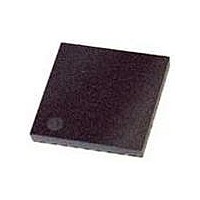ATMEGA168-15MZ Atmel, ATMEGA168-15MZ Datasheet - Page 255

ATMEGA168-15MZ
Manufacturer Part Number
ATMEGA168-15MZ
Description
MCU AVR 16K FLASH 15MHZ 32-QFN
Manufacturer
Atmel
Series
AVR® ATmegar
Datasheet
1.ATMEGA168-15MZ.pdf
(340 pages)
Specifications of ATMEGA168-15MZ
Package / Case
32-VQFN Exposed Pad, 32-HVQFN, 32-SQFN, 32-DHVQFN
Voltage - Supply (vcc/vdd)
2.7 V ~ 5.5 V
Operating Temperature
-40°C ~ 125°C
Speed
16MHz
Number Of I /o
23
Eeprom Size
512 x 8
Core Processor
AVR
Program Memory Type
FLASH
Ram Size
1K x 8
Program Memory Size
16KB (16K x 8)
Data Converters
A/D 8x10b
Oscillator Type
Internal
Peripherals
Brown-out Detect/Reset, POR, PWM, WDT
Connectivity
I²C, SPI, UART/USART
Core Size
8-Bit
Processor Series
ATMEGA16x
Core
AVR8
Data Bus Width
8 bit
Data Ram Size
1 KB
Interface Type
2-Wire, SPI, USART, Serial
Maximum Clock Frequency
20 MHz
Number Of Programmable I/os
23
Number Of Timers
3
Maximum Operating Temperature
+ 85 C
Mounting Style
SMD/SMT
3rd Party Development Tools
EWAVR, EWAVR-BL
Development Tools By Supplier
ATAVRDRAGON, ATSTK500, ATSTK600, ATAVRISP2, ATAVRONEKIT
Minimum Operating Temperature
- 40 C
On-chip Adc
10 bit, 8 Channel
Package
32QFN EP
Device Core
AVR
Family Name
ATmega
Maximum Speed
16 MHz
Operating Supply Voltage
3.3|5 V
Lead Free Status / RoHS Status
Lead free / RoHS Compliant
Available stocks
Company
Part Number
Manufacturer
Quantity
Price
Company:
Part Number:
ATMEGA168-15MZ
Manufacturer:
ATMEL
Quantity:
1 300
Part Number:
ATMEGA168-15MZ
Manufacturer:
ATMEL/爱特梅尔
Quantity:
20 000
- Current page: 255 of 340
- Download datasheet (6Mb)
22.4
22.5
22.6
22.6.1
7530I–AVR–02/10
Software Break Points
Limitations of debugWIRE
debugWIRE Related Register in I/O Memory
debugWire Data Register – DWDR
When designing a system where debugWIRE will be used, the following observations must be
made for correct operation:
debugWIRE supports Program memory Break Points by the AVR Break instruction. Setting a
Break Point in AVR Studio
tion replaced by the BREAK instruction will be stored. When program execution is continued, the
stored instruction will be executed before continuing from the Program memory. A break can be
inserted manually by putting the BREAK instruction in the program.
The Flash must be re-programmed each time a Break Point is changed. This is automatically
handled by AVR Studio through the debugWIRE interface. The use of Break Points will therefore
reduce the Flash Data retention. Devices used for debugging purposes should not be shipped to
end customers.
The debugWIRE communication pin (dW) is physically located on the same pin as External
Reset (RESET). An External Reset source is therefore not supported when the debugWIRE is
enabled.
The debugWIRE system accurately emulates all I/O functions when running at full speed, i.e.,
when the program in the CPU is running. When the CPU is stopped, care must be taken while
accessing some of the I/O Registers via the debugger (AVR Studio).
A programmed DWEN Fuse enables some parts of the clock system to be running in all sleep
modes. This will increase the power consumption while in sleep. Thus, the DWEN Fuse should
be disabled when debugWire is not used.
The following section describes the registers used with the debugWire.
The DWDR Register provides a communication channel from the running program in the MCU
to the debugger. This register is only accessible by the debugWIRE and can therefore not be
used as a general purpose register in the normal operations.
Bit
Read/Write
Initial Value
• Pull-up resistors on the dW/(RESET) line must not be smaller than 10k . The pull-up resistor
• Connecting the RESET pin directly to V
• Capacitors connected to the RESET pin must be disconnected when using debugWire.
• All external reset sources must be disconnected.
is not required for debugWIRE functionality.
R/W
7
0
R/W
®
6
0
will insert a BREAK instruction in the Program memory. The instruc-
R/W
5
0
ATmega48/88/168 Automotive
CC
R/W
4
0
DWDR[7:0]
will not work.
R/W
3
0
R/W
2
0
R/W
1
0
R/W
0
0
DWDR
255
Related parts for ATMEGA168-15MZ
Image
Part Number
Description
Manufacturer
Datasheet
Request
R

Part Number:
Description:
Manufacturer:
Atmel Corporation
Datasheet:

Part Number:
Description:
Manufacturer:
Atmel Corporation
Datasheet:

Part Number:
Description:
Manufacturer:
ATMEL Corporation
Datasheet:

Part Number:
Description:
IC AVR MCU 16K 20MHZ 32TQFP
Manufacturer:
Atmel
Datasheet:

Part Number:
Description:
IC AVR MCU 16K 20MHZ 32-QFN
Manufacturer:
Atmel
Datasheet:

Part Number:
Description:
IC AVR MCU 16K 20MHZ 28DIP
Manufacturer:
Atmel
Datasheet:

Part Number:
Description:
MCU AVR 16K FLASH 15MHZ 32-TQFP
Manufacturer:
Atmel
Datasheet:

Part Number:
Description:
IC AVR MCU 16K 20MHZ 32TQFP
Manufacturer:
Atmel
Datasheet:

Part Number:
Description:
MCU AVR 16KB FLASH 20MHZ 32QFN
Manufacturer:
Atmel
Datasheet:

Part Number:
Description:
MCU AVR 16KB FLASH 20MHZ 32TQFP
Manufacturer:
Atmel
Datasheet:

Part Number:
Description:
IC MCU AVR 16K FLASH 32-QFN
Manufacturer:
Atmel
Datasheet:











